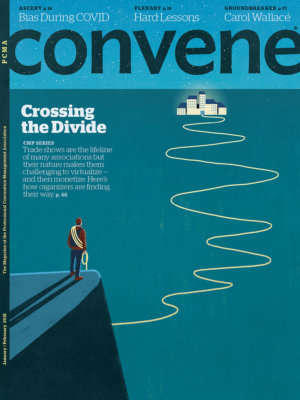
Trade shows are the lifeline of many associations but their nature makes them challenging to virtualize — and then monetize. (Illustration by SHOUT)
There’s no such thing as a virtual exhibition, said Jochen Witt during a Web Summit 2020 panel discussion in December. “It’s nonsense. It does not exist. An exhibition is feel, taste, smell, touch. It’s not possible virtually, it’s not possible digitally. Did you ever take a digital swim or a virtual meal?”
Witt, who is a partner and board member at jwc, a Germany-based management consultancy firm specializing in the trade fair and conference business, emphasized during the all-virtual Web Summit session that while conference after conference has migrated online during COVID-19, the nature of trade shows has made digitization a trickier proposition. “We need to make sure that we don’t simply transfer what we believe the physical event” to be, Witt said, “into a digital world.” Moreover, he said, “we need to apply digital tools to provide a better solution for whatever our purposes.”

Parul Shah
And a better solution for exhibitors, as well. Research conducted by Freeman indicates that 69 percent of exhibitors rate virtual events as only fair or poor, Parul Shah, Freeman’s vice president of data insights, told Convene. “On top of that, 63 percent of exhibitors said virtual events do not meet their goals,” she said. “We can and must do better for our exhibitor community.”
The exhibitions industry watched as the Consumer Technology Association (CTA), which hosts CES, the largest annual trade show in the U.S. — 4,400 exhibitors showcased tech innovations to 170,000 attendees in nearly 3 million net square feet of exhibit space in Las Vegas in 2020 — moved the event to a virtual platform in January. WIRED writer Lauren Goode had a less than stellar experience at CES 2021, writing, “‘Walking’ the virtual show floor at Pepcom — a product demo event for the media that occurs alongside CES — involved clicking on a quilt of logos one by one, a far cry from the usual booth- browsing and buffet-grazing that happens at the in-person event.” And her colleagues were equally let down by the virtual substitute, she said: “The serendipity of discovery was gone. One of the most exciting parts of CES has been finding a weird product in some back corner of the giant expo hall and learning about something new through pure chance. At a virtual CES, that’s a virtual impossibility.”
However unequal CES 2021 was to the physical event, its end goal — “bringing innovators together and showcasing how technology is changing lives for the better on a global scale” — remained the same, Gary Shapiro, CTA president and CEO, said in a pre-event video.
Certainly, in an extraordinarily difficult year, technology has been “the one bright spot in the cloud,” enabling people to connect, Shapiro noted. And it has been the silver lining in the business events industry — tech innovation and adoption has skyrocketed almost overnight, said Marco Giberti, founder and CEO, Vesuvio Ventures. “This year has accelerated a couple of decades into a couple of years,” said Giberti, who coauthored the new book, Reinventing Live: The Always-On Future of Events, with AMR International Executive Chairman Denzil Rankine.
Earn Certification Credits
Earn one clock hour of certification credit by visiting the Convene CMP Series page to answer questions about information contained in this article and the following articles:
- Experimenting With Virtual Reality
- What Do Health-Care Attendees Want From Virtual Exhibitors?
- COVID-19 And How It’s Changing the Event Industry, a white paper published by Reed Exhibitions
The Certified Meeting Professional (CMP) is a registered trademark of the Events Industry Council.
Economic and Other Hard Realities
And yet, technology hasn’t shored up the exhibition industry from an economic perspective. According to a report published in 2019 by the Global Association of the Exhibition Industry, UFI, exhibitors and visitors combined spent around $137 billion every year on exhibitions.
That was pre-pandemic. Financially, on average, virtual events are small (49 percent generate gross revenues of less than $250,000) and yield a fraction of the gross revenues of physical events, according to “Anatomy of Virtual Events and Financial Outcomes,” a report published in January by the Center for Exhibition Industry Research (CEIR).
Virtual trade shows present economic challenges for both associations, which have lost significant revenues the in-person exhibit hall generated, and for exhibitors, who struggle to replicate the lead generation and deal-making that takes place on the physical show floor.
Despite these difficulties, organizers have forged ahead. The shift to digital for in-person exhibitions forced to cancel in 2020 grew from 69 percent in April to 81 percent in June, according to a CEIR survey. Most notable is the increase in fully virtual trade shows during those few short months between the two surveys — from 15 percent to 41 percent. At the same time, despite Zoom fatigue, attendees and members working from home still seem to have an appetite for virtual events. In September, 59 percent of attendees reported they would be likely to sign up to attend an online trade event, up two points from June, according to “COVID-19 And How It’s Changing the Event Industry,” a white paper published by Reed Exhibitions. The percentage of attendees who think they can still carry out the majority of their event objectives online, Reed’s research found, is also increasing, up from 52 percent in June to 57 percent in September.
It’s up to trade-show organizers to keep that spark alive. Convene spoke with organizers — and suppliers and tech experts — about the challenges of producing online trade shows in 2020 and what they envision for 2021. As more organizations look to incorporate virtual exhibits into their strategies to make up for lost revenues, what are the most innovative and practical approaches? How are groups getting attendees to engage and to create online environments that are interactive? How are shows pricing virtual booth space and involving sponsors in a meaningful way? And in the end, will the organization be able to replace the revenue the in- person exhibit hall generated? Here’s what we learned.
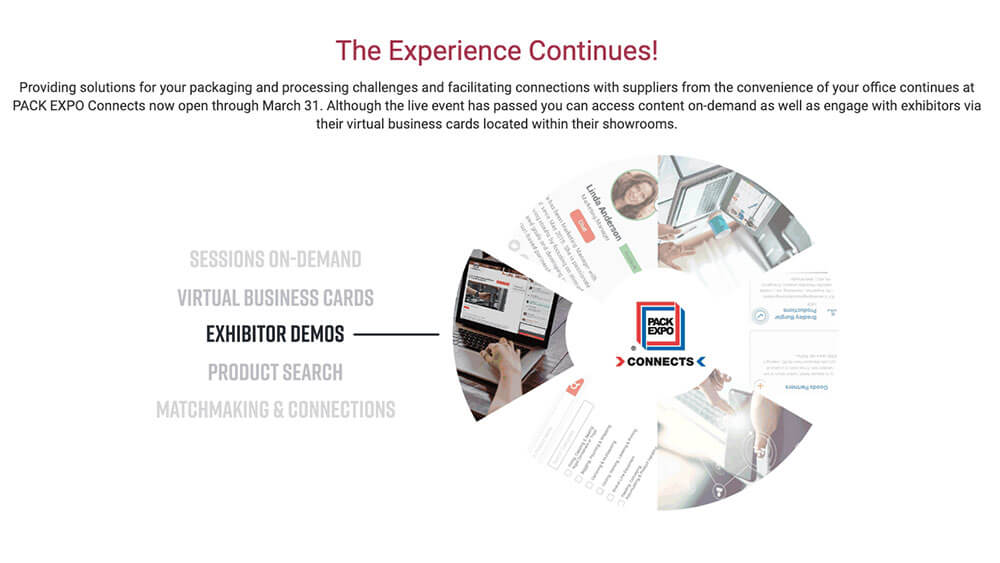
The all-virtual PACK EXPO Connects, which had 2,600 live exhibitor demos planned demos planned for the November event, overcame initial hiccups the event’s first day to be able to share those demos. The experience continues on the event site until March 31.
Overcoming Tech Issues

Marco Giberti
The good news: “The technology is becoming more affordable, more robust, and it’s working,” said Giberti, who spent 18 years of his career working for Reed Exhibitions and now consults and invests with media, event, and technology entrepreneurs. “Event organizers don’t need to build it from scratch or experiment with crappy startups anymore.”
Despite the hundreds of off-the-shelf event platforms available, however, the technology is not perfect. Many organizers report technical issues, bandwidth problems, and overload of software systems during their online events.
Case in point: PACK EXPO Connects, an all-virtual event that replaced the in-person trade show scheduled for Chicago’s McCormick Place in 2020, which is organized by PMMI, the association for packaging and processing technologies. When digital PACK EXPO Connects launched on Nov. 9, the system — accommodating nearly 18,000 attendees and more than 700 exhibitors — crashed on the first day within 15 minutes of opening the exhibitor platform to attendees.
“We’re a machinery show, so being able to show the equipment was so important,” said Laura Thompson, PMMI’s vice president, trade shows. As part of an exhibitor package, PMMI deployed and sold live demos — “we had 2,600 live demos,” she said, “within the platform scheduled in a one-week period of time.”
When the system didn’t come back online, show management resorted to Plan B. “Our backup plan was either the exhibitors could upload pre-recorded videos or they could use their own platform, like Zoom or Teams,” Thompson said. “We emailed and then personally called 500-plus exhibitors because time was of the essence. We wanted to make sure people didn’t miss that opportunity.”
Thompson said she was “impressed with our exhibitors and how quickly they were able to switch and accommodate the changes. We were still able to have demos, but not in the platform we had offered.”
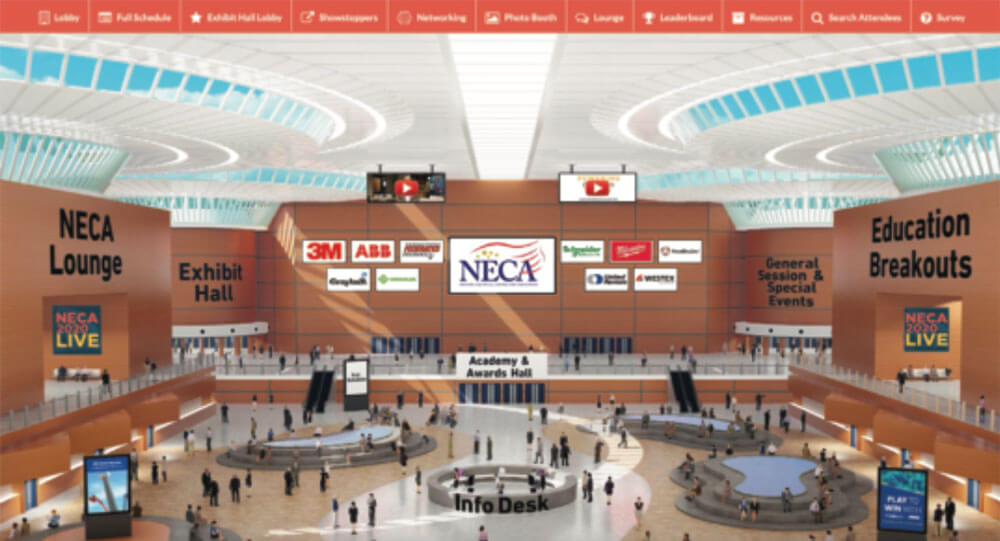
The National Electrical Contractors Association worked with vFairs and Gatherly to produce its virtual trade show.
Bringing in Experiences
In June 2020 when the National Electrical Contractors Association (NECA) realized they had no choice but to cancel the in-person portion of NECA 2020 Chicago, scheduled for October, the exhibit floor was already 85-percent sold for McCormick Place. The team offered those exhibitors who had already paid four options: transfer the balance to a virtual convention and trade show, receive a refund, apply it to sponsorship, or transfer the balance to NECA 2021 Nashville, to be held in early October.
“Typically, the show attracts 300 companies exhibiting in the trade show,” said Susan McCart, president, HFI Event Services, which handles exhibit and sponsorship sales for NECA. “We were pleased with 94 companies that decided to join us for first-ever NECA 2020 LIVE.”
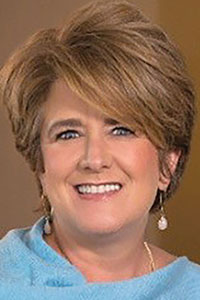
Beth Ellis
From Oct. 6–8, NECA 2020 LIVE offered 84 education sessions and product demos from 22 companies. NECA worked with virtual event software company vFairs and online event platform Gatherly to produce the digital event.
NECA’s in-person attendance is usually around 8,000–10,000 and the digital event attracted 5,104 live participants — of which 1,200 were first-timers working in the electrical construction industry. NECA had been trying to attract a broader audience to its annual convention for years, so that number was significant. “We have always wanted to dig deeper within electrical firms and bring in not only CEOs and owners, but also project managers, estimators, and accountants,” said Beth Ellis, NECA’s executive director of convention and meetings. “We were able to do that by bringing the price point down and eliminating travel costs.”
NECA charged members $200 for registration and charged non-members $500, compared with in-person fees of $1,200 for members and $1,500 for non-members.
“When we began planning NECA 2020 LIVE, we had great ambitions, but you never quite know how attendees are going to respond to such a massive change,” Ellis said. “We were absolutely floored by the response, with thousands of NECA members and other electrical industry figures all coming together and using our platform to engage. We could not be more thrilled to see this success and hear how great the experience was both for loyal NECA convention attendees, and those who had never been able to travel before.”
While NECA had only a fraction of the attendance and exhibitors they host in person, they did have some exhibitor and attendee stats worth celebrating: 67,330 booth visits and 34,829 session views for a total engagement of 102,159 clicks (as of Dec. 18).
To encourage attendee engagement, NECA offered demos, education theaters, chat functionality — and weaved in elements from the physical event. For example, NECA typically offers lunch and entertainment on the show floor. On the first day, supply-chain-management company Graybar sponsored a chocolate and bourbon demo, and NECA offered prizes that could be redeemed only by visiting each sponsor’s booth. On day two, the lunch hour featured a cooking demonstration by Washington, D.C.–area chef George Rodrigues, who whipped up a batch of chili from the recipe that led to his win on Food Network’s “Beat Bobby Flay.” On day 3, to promote NECA 2021 in Nashville, country music singer Ryan Jewel sang and took requests, and NECA gave away a pair of cowboy boots.
“We wanted to bring in just everything that our members were accustomed to experiencing in person,” Ellis said. “We brought in entertainment, education, networking, and exhibits. People’s minds were blown.” Leading up to the event, NECA worked with local chapters to present the platform and offer tips on enhancing the user experience — a step that can be vital to a virtual trade-show event’s success (see “Don’t Skimp on the Prep Work” at the end of this story).
NECA also hosted online evening activities. The one-and-a-half-hour-long opening reception featured the Milwaukee Tool Shed Band, one of the show’s largest exhibitors, with two pre-recorded sets. Dueling pianos were a highlight of the second evening, and Chicago’s Second City provided the final night’s entertainment.
During the receptions, NECA used Gatherly’s networking feature to promote interaction. “If you were walking around, [your avatar] could come and grab [my avatar],” Ellis said. “Then your group could get on an elevator and go to different levels. We had 15 different levels with caricatures, bingo, trivia, and more. We also had a private room where you could go and chat. You could even lock the room if you wanted to have a private party or conversation.”
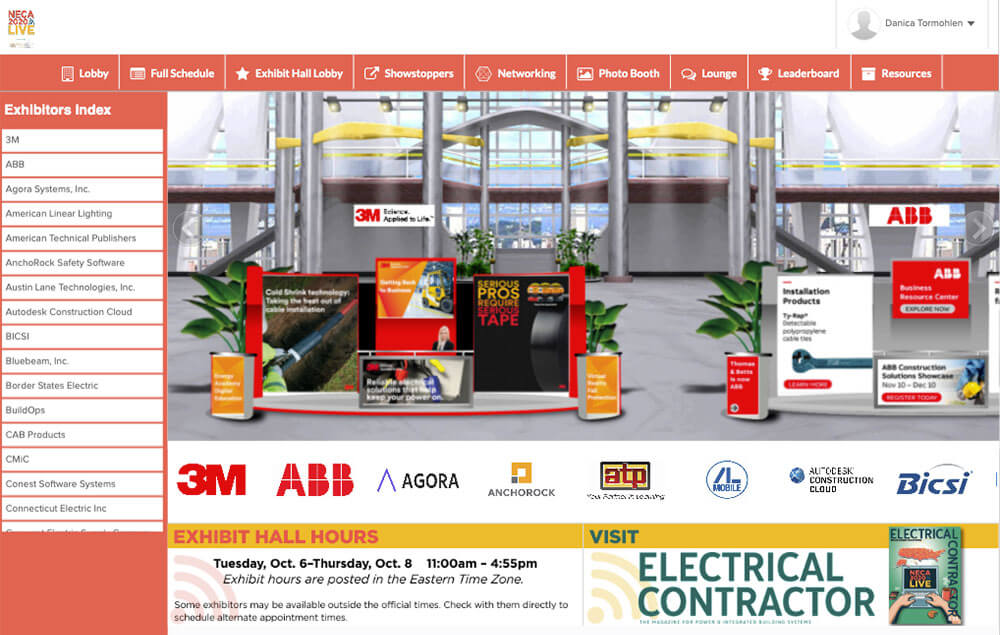
NECA 2020 LIVE offered 84 education sessions and product demos from 22 companies. The virtual event met the association’s longtime objective of attracting a new audience to its trade show with 1,200 first-time attendees.
Changing the Exhibitor’s Mindset
Show organizers are finding that virtual trade shows require exhibitors to shift their thinking. “First and foremost,” Freeman’s Shah told Convene, organizers need to “help exhibitors understand they need to show up differently, change their mindset, and reset expectations. It’s not about replicating your in-person experience online. What we’re learning from the data we’re collecting is that online is all about opening doors, broadening the sales funnel, and bringing in new people. It’s about getting a broader audience familiar with your products and services.”
Like an in-person trade show, virtual attendees want education and networking in addition to the opportunity to view new products and services. In fact, 62 percent of online attendees report they come for content and learning, according to research by Freeman. “Content and learning is the No. 1 attendee driver for participation in virtual,” Shah said. So the question then becomes, she said, “How do you bake in that layer from an exhibitor point of view?”
SINGEx CEO Aloysius Arlando, a Web Summit session co-panelist with Witt, said that when it comes to a conference versus a trade show, “the story is totally different. In a conference, of course, you can go much more virtual because you have more content to deliver and it’s much easier to do that virtually. The more content you have in an exhibition,” he added, “the easier it gets.” Similarly, Shah said, “The more exhibitors can be integrated into the overall programming, the more successful they will be.” For exhibitors, that means “hands down, anything with sponsored content,” she said. “Our data reveals exhibitors have greater success with lunch and learns, small group learning sessions, and product demos. Sponsored content typically drives longer engagement times than a visit to an exhibitor listing.” She said sponsoring a lunch and learn at a health-care event can cost as much as $20,000.
NECA sold out all 24 30-minute education timeslots it had created exclusively for exhibitors, McCart said. “We sold 27 five-minute commercials that were played in between the education sessions, and these also all sold out.”
“Obviously, the goal is to get people down to the bottom of the sales funnel, but that’s not where online lives,” Shah said. “First, we have to recognize that coming to online doesn’t mean you’re going to close deals. It’s about nurturing relationships. It is about brand awareness. It is about bringing the most innovative content that is not available anywhere else. It’s only available at this event, at this moment in time.”
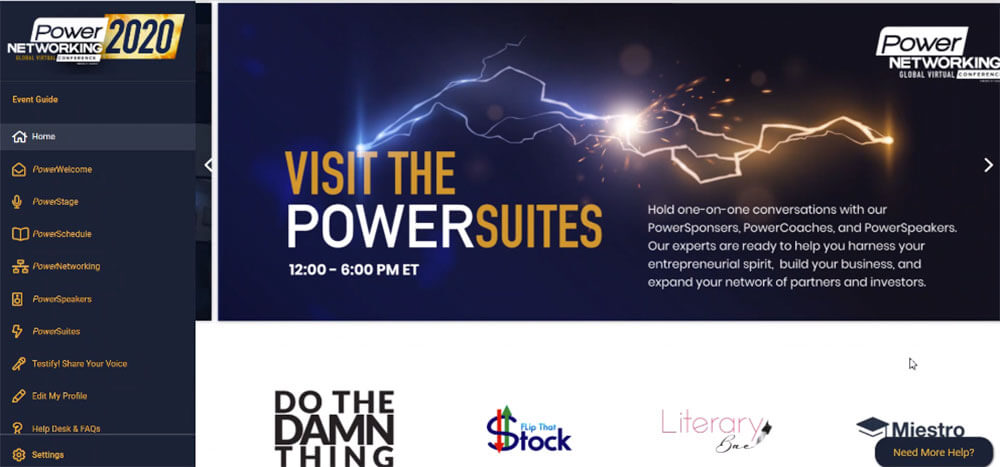
Power Networking Conference offered tiered pricing with customized options for exhibitors based on their goals and objectives. ‘Digital levels the playing field and you shouldn’t fight it,’ said the event’s organizer, Kara Dao.
Engagement Takes a Different Form
“Engagement takes a lot of work — whether you are in person or online,” said Skip Cox, SVP, research and measurement, Freeman. “If you’re willing to put in the time in advance, you can create engagement.”

Kara Dao
Chance meetups, however, are far less likely to occur online than in-person. “Attendees are always one click away from engaging — and disengaging,” said Kara Dao, CEM, senior director, client engagement and operations for Washington, D.C.–based third-party event producer JDC Events. In 2020, Dao worked on PowerNetworking Conference, an event for black entrepreneurs, and with the International Association of Assessing Officers (IAAO), to produce virtual events with exhibits to replace their in-person events. Both events used virtual event platform Eventfinity and its virtual breakout room feature vMeet to step up engagement.
The vMeet feature was “like walking about with a meeting room in your backpack,” Dao said. “Attendees and exhibitors can invite each other to chat and can create a meeting room anytime with one click.” JDC used push notifications during the virtual events to guide the attendee journey, sending reminders to promote interaction with exhibitors or upcoming events on their schedules — but no more often than every 30 minutes.
Dao also built exclusive exhibit hours into the agenda. IAAO featured a business-card exchange with a one-click autofill form for attendees to enter into a drawing for a tablet computer. “Attendees visited every booth,” she said. “Exhibitors offered entertainment, like caricatures, chef demos, mixology, karaoke, DJs, and prizes.”
While prizes and gamification can drive traffic, Shah said there are caveats. “Gamification can be good for brand aware- ness but make sure it aligns with your exhibitors’ goals and objectives,” she said. “It requires thoughtful planning and execution to drive results that are aligned with goals. Are you driving the right person to the booth? Gamification doesn’t necessarily drive longer engagement so there’s a trade-off.”
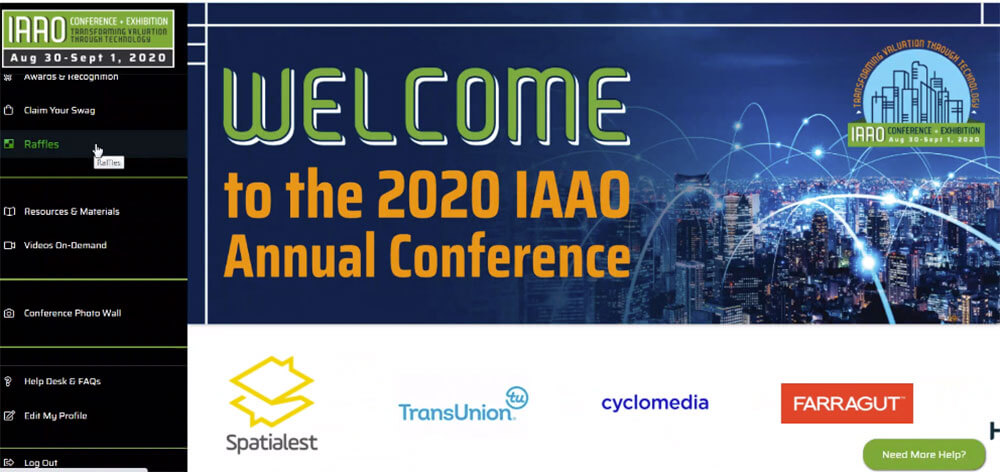
The International Association of Assessing Officers used virtual event platform Eventfinity’s breakout room feature vMeet at its event.
Making Connections
When the International Association of Exhibitions and Events (IAEE) pivoted from hybrid to all-virtual for its Annual Meeting and Expo!Expo! in December, Vice President of Exhibitions and Events Scott Craighead, CEM, and his team selected virtual event tech company Swapcard after an extensive RFP process for platforms that make connections. “One week before the event, hundreds of people were already active on the site and making connections,” he said. “Exhibitors were asking for appointments. They’ve got the attendee demographics, and there’s matchmaking AI in the platform that makes it easier for the exhibitors to navigate towards their prospects or customers with whom they want to connect.” IAEE opted to hold designated show hours over the course of two days, the same schedule as the in- person event.
In Shah’s experience, “one-on-one meetings are struggling. We’re just not seeing the numbers we would like to see.” One successful approach, she said, was taken by ECEF (Exhibition & Convention Executives Forum), held online in November: Tech demos had dedicated office hours with exhibitors available to answer questions. “Those tend to be way more successful than me scheduling a time to follow up with you later,” she said. “That’s just not happening.”
Making it seamless and easy for attendees and exhibitors to interact is key. “I think that’s where we are now,” Arlando said in his session. “It’s not to say that physical is good and digital is bad, but how actually do we weave in these different engagement opportunities and therefore bring about very high-value moments of interaction?”
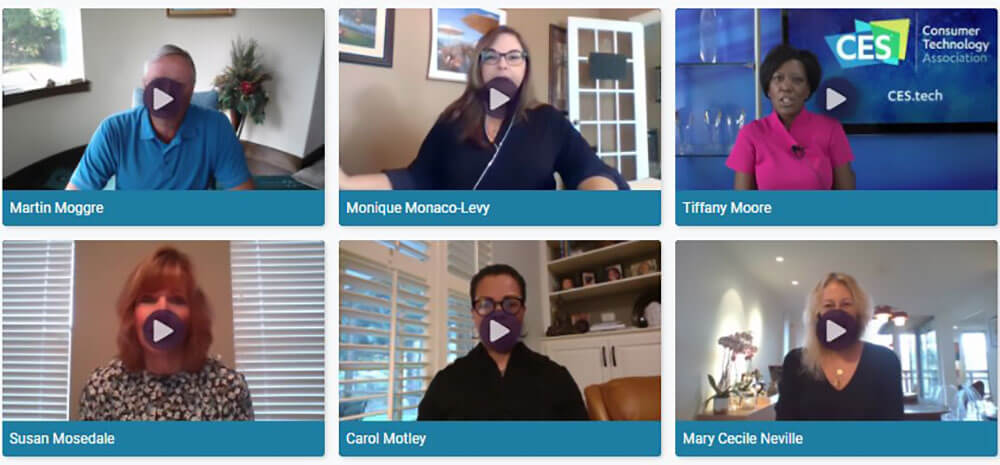
ECEF (Exhibition & Convention Executives Forum) opened its event platform early for networking and invited attendees to “View intro videos of dozens of industry leaders & make appointments” with them during the conference.
What’s Next
One of the benefits of digital events is the year-round engagement opportunities it offers as opposed to one-off physical events. “As an event organizer, you need to provide leads to your exhibitors and facilitate those connections with buyers,” Giberti said. “If you can use technology all year long and provide your customers with leads as a subscription service, there are opportunities, which means instead of selling a trade show, you’re going to be selling a year-long membership engagement. We’re moving from three or four days to 365 mobile, and associations, in particular, could and should capitalize on that opportunity. Associations have a strategic advantage because of their relationship with members and because of the data they could and should collect. The way associations can put those buyers and sellers together from a different angle … that is pretty interesting. It is very easy to say, but it’s very difficult to execute.”

Scott Craighead
IAEE will be testing the concept of extended engagement this year. “We’re going to roll out a year-round marketplace called ‘Market Hub,’” Craighead said. “That will launch in February with Swapcard, and it’ll be a longer-term solution, replacing our existing buyers guide. It will be a year-round buyer/seller environment. It’s certainly something positive that’s come out of this crisis. We’ve needed to do this for a long time.”
The future of the exhibition industry is hybrid, said Dale Parmenter, CEO of U.K.-based communications company drpg, during in his PCMA Convening Leaders 2021 presentation in January. Future in-person exhibitions will have a smaller audience and a large online audience, and “we clearly can’t just stick a camera in an exhibition and hope the people at home are going to be engaged,” Parmenter said. “They’re going to have to have something different.” He suggested taking the same kind of backstage approach that viewers see on sporting events, where a host or facilitator takes the online audience around for interviews with exhibitors and others on the show floor.
Giberti predicted that “in the next five or 10 years, we’re going to see more associations building their own platforms or potentially partnering with existing B2B marketplaces. But it’s not going to happen in six months. It’s going to take a long period of time.”
His advice: “Think like a startup. You will need to try, fail, fix it, pivot a little bit, and do it again. There is no magic trick.”
Don’t Skimp on the Prep Work
“We had no idea how much training was needed,” said PMMI’s Laura Thompson about the packaging and processing technologies association’s first-ever all-digital trade show, PACK EXPO Connects. “We did a lot of training on the exhibitor side for the live demos and showing them how to upload their assets and how to go through a test run. We tried to keep them very short and specific with 10-minute tutorials. We ended up with so much content that we had to organize it and make it easy for exhibitors to find what they were looking for.”
Attendee training also proved crucial. “We discovered as we got closer to the show that we needed training on the attendee side, as well,” Thompson said. “We put together an attendee webinar to show them how to search the site, how to make a plan, and how to schedule demos. It was a lesson learned. In the future, we’ll look to do this more on the attendee side.”
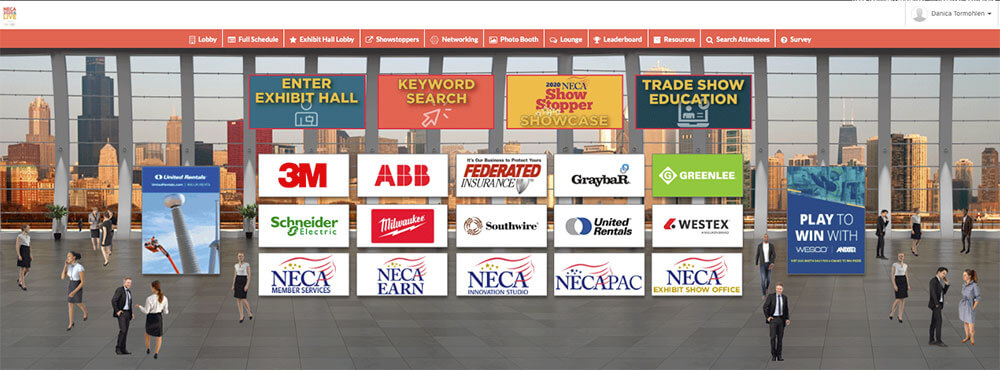
NECA charged $3,500 for its virtual exhibit, compared with $3,800 for a physical 10’x10′ booth space.
Exhibit Pricing, Revenue Generation, and KPIs
Pricing for virtual exhibitors runs the gamut, but JDC Events’ Kara Dao has one recommendation: “Maintain at least half the pricing of in-person,” she advised. For PowerNetworking Conference and the International Conference on Assessment Administration, two virtual events Dao organized, “we offered tiered pricing with customized options for exhibitors based on their goals and objectives. Digital levels the playing field, and you shouldn’t fight it.” She offered exhibitor-led roundtables and fireside chats as part of a menu of options. For one event, the base price was $3,000 for a virtual booth.
“I will say that the world is learning, which means we have to make our best educated guess on pricing and see if that is real or fair or not,” Vesuvio Ventures’ Marco Giberti said.
“We’re still in early days, but we are way better than a year ago,” he said. “There is no cookie-cutter situation or you can put this price in and it’s gonna work.”
“We definitely spent a lot of time talking about pricing internally,” IAEE’s Scott Craighead said. “When we made the switch from hybrid to virtual, we wanted to convert as many exhibitors as possible. Obviously, we wanted to create a price point that was going to be attractive.” IAEE charged $1,500 to exhibit, with some add-ons to enhance their booth presence.
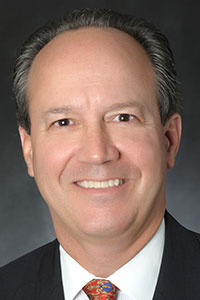
David DuBois
“That’s close to 40 percent of our rack rate on site,” said IAEE President and CEO David DuBois. “On average, we charge $40 per square foot in person. That’s $4,000 for a 10’×10′. We completed a competitive analysis to find out what others were charging.”
NECA charged $3,500 for its virtual exhibit, compared with $3,800 for a physical 10’x10′ booth space. “We wanted to charge close to the same amount as in-person, especially because there wouldn’t be any set-up fees, shipping, or travel expenses,” NECA’s Beth Ellis said.
Eking Out Little or No Revenue
While some organizers are generating revenues online, many are not replacing the on-site revenues. But for some, that’s okay since revenue isn’t the only goal. “One client recouped all its exhibitor and sponsorship revenue online while also exceeding attendance goals,” Dao said. Another client “met its KPIs,” she said, “which was to promote its selling speaker base.”
For PACK EXPO Connects, “we didn’t look at this as a revenue opportunity,” said PMMI’s Laura Thompson. “For us, it was about how do we stay relevant in the market? How do we give our exhibitors a chance to make a connection and capture leads? PMMI charged a fee for virtual exhibits and live demos, but we offered refunds to all because [we had] technical issues.”
IAEE averages about 275 exhibitors for its Expo!Expo! “By the fall, we were looking at about 130 companies,” Craighead said. “Of those, we converted 105 to virtual. We were really pleased with the number who converted.” That means the virtual exhibits generated $157,500, compared with 275 exhibitors at a minimum of $4,000 per for a 10’×10′.
“After expenses, it’s not going to be very profitable,” DuBois said. “I’ve heard platforms are anywhere from $100,000 to $300,000, depending on what you want. We negotiated a trade with Swapcard, and I can’t disclose what we ended up paying.”
Craighead added: “The platform pricing is going to continue to fluctuate because everyone’s trying to find the sweet spot, and the market will dictate what is acceptable. It’s evolving quite a bit.”
In Las Vegas in December 2019, IAEE drew more than 900 show organizers, DuBois said. “We had almost 500 show organizers virtual, so we were at 60 percent. Registration to the expo is free, but the full conference registration is $299 online. Our virtual revenue will be anywhere from 10 percent to 13 percent of our in-person Expo!Expo! Profitability will be about 15 percent.”
One of the catchphrases circulating this year: We are trading physical dollars for virtual dimes. “It’s getting closer,” Craighead said, “to a quarter.”
Danica Tormohlen was editor at large at Trade Show Executive magazine and is the former editor in chief of EXPO Magazine. She is based in the Kansas City, Missouri metro area.

